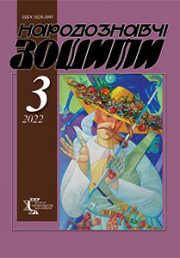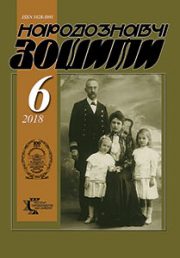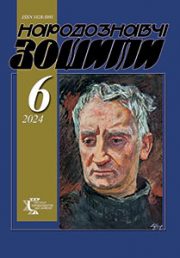The Ethnology Notebooks. 2021. № 6 (162), 1376—1384
UDK [930.2:398.23](4+7)”1920/2020″
DOI https://doi.org/10.15407/nz2021.06.1376
HISTORIOGRAPHY OF BAWDY FOLKLORE IN EUROPE AND NORTH AMERICA
(1920—2020)
MAYERCHYK Maria
- ORCID ID: https://orcid.org/0000-0002-7535-4319
- Candidate of Sciences, Senior Research Associate,
- Ethnology Institute of the National Academy of Sciences of Ukraine,
- Social Anthropology Department,
- 15, Svobody Ave, 79000, Lviv, Ukraine,
- Contacts: e-mail: mayerchykmaria@gmail.com
Abstract. This paper offers a review of the 1920—2020 publications in Ukraine and other Slavic countries and North America, exploring bawdy folklore in particular and ethnography of sexuality in general. The paper primarily focuses on publications relating to Ukrainian or, more generally, Slavic ethnography.
Besides, periodization of the publications on bawdy folklore is conducted, and the main methodological frameworks of each period are identified. In particular, in the paper, I define the period of the 1920s—1930s when a number of publications in Bulgaria, Serbia, Ukraine, the Czech Republic, and Russia appeared.
Based on these publications, I show the growing tendency to the medicalization of the ethnography of sexuality at that time. The next period, encompassing the 1960s—1970s, is characterized by the influence of psychoanalysis. The application of the psychoanalytic framework to folklore studies is exemplified by works of the USA scholars. Structural-semantic studies of bawdy folklore were typical for the 1980s—2000s. Here I review works examining Slavic folklore. In the final chapter, I consider publications of the Ukrainian scholars in the 2000s till now. These publications are characterized by the search of methodologies.
Keywords: bawdy folklore, Slavic folkloristics, historiography of folklore.
Received 23.10.2021
REFERENCES
- Mayerchyk, M., & Boriak, O. (Eds.). (2018). «Erotic Folklore as Discursive Category». Inventing the Obscene. The Hidden Collections of Fedir Vovk: The Ethnography of Sexuality in the Late 19th and Early 20th Centuries (Pp. 1—50).Kyiv: Krytyka [in Ukrainian].
- Mayerchyk, M., & O. Boriak (Eds.). (2013). «History of Ethnography-of-Sexuality and Obscene Folklore». Ethnology of Sexuality and the Body (Pp. 9—16). Kyiv: Center for Cultural Anthropological Studies [in Ukrainian].
- Tantsiura, H. Collection of folk proverbs — traditional, bawdy, Russian, bawdy riddles, and fables. Recorded in village Ziatkivtsi, Haisyn district Tulchyn area (Podillia) by Hnat Trokhymovych Tantsiura in 1921—1929. VANFRF IMFE NANU. Fonds 1—5. Item 389. Pp. 46—111 [in Ukrainian].
- Karnaukhova, I. Tales recorded in Stalin region, 1930. VANFRF IMFE NANU. Fonds 1—5. Item 451 [in Ukrainian].
- Matushevska, D.O. Songs, vesnianky, chastuchky, proverbs, riddles recorded by me and others, 1925. VANFRF IMFE NANU. Fonds 1—5. Item 410 [in Ukrainian].
- Drobotiuk, І. Legends, songs, chastushky, kolomyiky, dancing songs, poems, folk calendar, family rituals and others, 1915. VANFRF IMFE NANU. Fonds 1—5. Item 386 [in Ukrainian].
- Pashkivskyi, А. Riddles, 1929. VANFRF IMFE NANU. Fonds 1—4. Item 291 [in Ukrainian].
- Denysenko V. (1928). «Wedding rituals and rites in Ukraint» by Khv. Vovk in the first Bulgarian and the second French edition. Primitive society and its remnants in Ukraine, 2—3, 143—161 [in Ukrainian].
- Volklov, F. (1890—1891). The wedding rites of the Slavic peoples. Sbornik za narodny umotvorenia, nauka i kninzhnina (Vol. III, pp. 137—178; Vol. IV, pp. 194—230; Vol. V, pp. 204—232) [in Bulgarian].
- Volkov, Theodore. (1891—1892). Wedding rites and customs in Ukraine. L’Anthropologie (Vol. II, pp. 160—184, 408—437, 537—587; Vol. III, pp. 541—588) [in French].
- Savchenko, F. (1926). Fellows and girls communities in Ukraine. Primitive society and its remnants in Ukraine, 3, 85—92 [in Ukrainian].
- Hrushevska, К. (1927). On primitive domestic affairs: Several comments about women’s domestic magic in relation to the oldest forms of women’s domestic affairs. Primitive society and its remnants in Ukraine, 1—3, 9—44 [in Ukrainian].
- Hrushevskyi, М. (1921). Beginnings of citizenship. [in Ukrainian].
- Sheitanov, N. (1932). Sexual philosophy of Bulgarians. Filosofski prehled, 3, 241—256 [in Bulgarian].
- Sheitanov, N. (1934). Erotic cosmology in Balkans. Filosofski prehled, 3—4, 300—312 [in Bulgarian].
- Sheitanov, N. (1935). Introduction to Bulgarian sexology. Filosofski prehled, 5, 428—41 [in Bulgarian].
- Sheitanov, N. (1936). Seksokratia. Filosofski prehled, 2, 149—161 [in Bulgarian].
- Gidikov, S. (1934). Sexual constraint of Bulgarian as a foundation of his charachter. Filosofski prehled, 6, 123—32 [in Bulgarian].
- Kostich, А. (1933). Sexuality in Serbian folk poetry. Beograd: Narodna shtamparyia Myrko Drobats [in Serbian].
- Obratil, K. (1932—1939). Kryptadia: contributions to the study of the sexual life of our people (Issue 1—3). Praha: Soukromy tisk, nakladem vlastnim [in Czech].
- Nikiforov, A., & Toporkov, A. (Ed.). (1996). Erotica in the Great Russian tale. Sex and erotica in the Russian traditional culture (Pp. 509—518). Moscow: Ladomyr [in Russian].
- Adrianova-Perets, V., & Toporkov, A. (Ed.). (1996). Symbolism of dreams by Freud in light of the Russian riddles. Sex and erotica in the Russian traditional culture (Pp. 519—528). Moscow: Ladomyr [in Russian].
- Bogatyriov, P., & Toporkov, A. (Ed.). (1996). Games in funeral rites of Transcarpathia. Sex and erotica in the Russian traditional culture (Pp. 484—508). Moscow: Ladomyr [in Russian].
- Voloshyn, P. (1994). History of the Ukrainian Institute of Сlinical and Experimental Neurology and Psychiatry. History of Ukrainian Psychiatry (Pp. 3—7)[in Russian].
- Gurevich, Z., & Vorozhbyt, А. (1931). Sex life of a peasant woman. Kharkiv: Medvydav [in Ukrainian].
- Gurevich, Z., & Grosser F. (1928). Contemporary sex life. Kharkiv: Derzhavne vydavnytstvo Ukrainy [in Ukrainian].
- Halicheva, N., Petrova, Z., & Ohnev, V. (2013). Famous social-hygienist Z. Gurevich. Medicine today and tomorrow, 4 (61), 38—42 [in Ukrainian].
- Коs, М. (1908). About sex life. Lviv: NTSH [in Ukrainian].
- Yefimov, А. (1930). How can we explain sex life to children. Kharkiv: Naukova dumka [in Ukrainian].
- Hlezer, М. (1930). Sex life. Kharkiv: Naukova dumka [in Ukrainian].
- Hoffmann, F. (1962). Panel on Folk Literature and the Obscene: Introduction. The Journal of American Folklore 75, 297, 189.
- Legman, G. (1962). Misconceptions in Erotic Folklore. Journal of American Folklore, 75 (297), 200—208.
- Legman, G. (1968). Rationale of the Dirty Joke: Rationale of the Dirty Joke. New York: Grove Pres.
- Legman, G. (1975). No Laughing Matter: An Analysis of Sexual Humor. New York: Breaking Point.
- Tarasevskyj, P. (1909). The Sex Life of the Ukrainian Peasants: Folkloric Surveys from the Russian Ukraine (Vol. 3). Leipzig: Deutsche Verlagaktiengesellschaft [in German].
- Hnatjuk, V. (1912). The sex life of the Ukrainian peasants in Austria-Hungary (Vol. 5). Leipzig: Ethnologischer Verlag [in German].
- Brottman, M. (2004). Funny Peculiar. Gershon Legman and the Psychopathology of Humor. New York, London: Routledge.
- Coffin, T. (1978). The Proper Book of Sexual Folklore. New York: The Seabury Press.
- Karadzic, V. (1981). Crven ban: erotske narodne pesme. Beograd: Prosveta.
- Fridrih S. Kraus, (Ed.). (1986). Mrsne price: erotska, sodomijska i skatoloska narodna proza, priredio i izabrao Dusan Ivanic. Beogradski izdavacko-graficki zavod.
- Burt, R.F.(2009). S. Krauss (1859—1938): Testimonials and materials for the bibliography of folklorist, writer and sex researcher. South Slavs’ secret stories (Pp. 7—134). Moscow: Ladomyr [in Russian].
- Toporkov, A. (Ed.). (1995). Russian erotic folklore. Moscow: Ladomyr [in Russian].
- Toporkov, A. (Ed.). (1996). Sex and erotica in the Russian traditional culture. Moscow: Ladomyr [in Russian].
- Levitt, М., & Toporkov, A. (Eds). (1999). Eros and Pornography in Russian Culture. Moscow: Ladomir.
- Volodina, T., & Fedosik, A. (Eds). (2006). Belorusian erotic folklore. Moscow: Ladomyr [in Russian].
- Kraus, F. (2009). South Slavs’ secret stories. Moscow: Ladomyr [in Russian].
- Ајdachyћ, D. (Ed). Erotic in Slavic folklore: a collection of papers. Beograd: Stubovy kulture.
- Ајdachyћ, D. (2013). Erotoslavija: the Transfiguration of Eros in Slavic Literatures. Beograd: Albatros Plus.
- Krasykov, M. (Ed.). (2003). Ukrainian bawdy songs. Kharkiv: Folio [in Ukrainian].
- Sulyma, M. (Ed.). (2001). Bandurka: Ukrainian bawdy songs recorded by Z. Dolenga-Khodakivskyi, М. Мaksymovych, P. Lukashevych, М. Hohol, Т. Shevchenko, P. Chubynslyi, F. Vovk, І. Franko, V. Hnatiuk. Kyiv: Dnipro [in Ukrainian].
- Mayerchyk, M., & Boriak, O. (Eds.). (2013). Ethnology of Sexuality and the Body. Kyiv: Center for Cultural Anthropological Studies [in Ukrainian].
- Mayerchyk, M., & Boriak, O. (Eds.). (2018). Inventing the Obscene. The Hidden Collections of Fedir Vovk: The Ethnography of Sexuality in the Late 19th and Early 20th Centuries. Kyiv: Krytyka [in Ukrainian].
- Vovchak, А. (2010). «Collection of the Ukrainian kryptadia «Das Geschlechtleben des ukrainischen Bauernvolkes…» (Leipzig, 1909—1912): its history and reception». Zapysky NTSH (Vol. ССLIX, pp. 639—693) [in Ukrainian].
- Vovchak, А. (1999). Volodymr Hnatiuk — a researcher of the Ukrainian kryptadia. Scholarly Notes: Literary Studies, 4, 96—117 [in Ukrainian].
- Koval-Fuchylo, I. (2013). Bawdy lamentations as genre of the Ukrainian weeping tradition. Mythology and Folklore, 2—3, 70—75 [in Ukrainian].
- Shevshuk, Т. (2005). «I used to have a steam machine… »: blacksmith code of the Zhytomyr Polissia facetious songs with double «refrain». Mythology and Folklore, 1—2, 46—52 [in Ukrainian].
- Khai, М. (2007). Bawdy elements in the Ukrainian dance folklore. Folk Art and Ethnology, 2, 22—29 [in Ukrainian].
- Horblianskyi, I. (2014). Folk miniature kryptadia from Boikivshchyna: pro et contra. Mythology and Folklore, 1—2, 120—36 [in Ukrainian].







